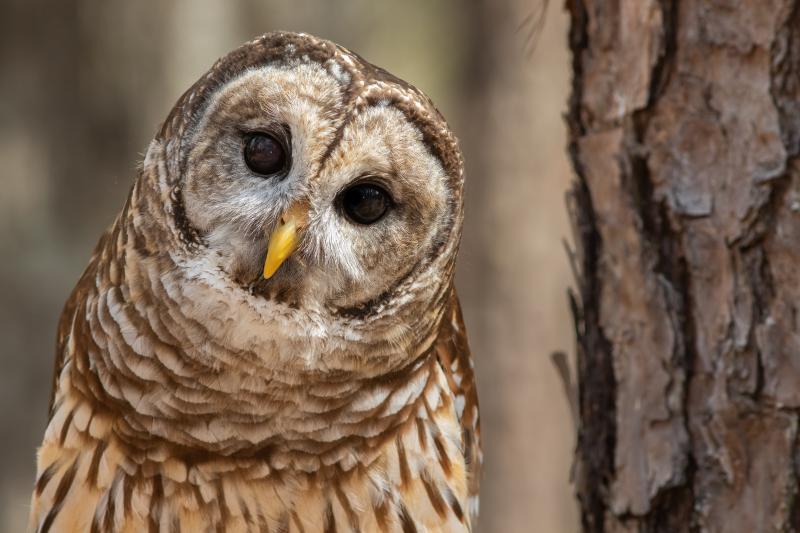Local owl species are expert birds of prey
Editor’s note: Cape Gazette is proud to introduce Wild Cape, a monthly column by Alice Mohrman dedicated to the rich and diverse ecosystem of Delaware’s Cape Region. It is our hope to bring readers closer to the natural world by exploring fascinating creatures, plants and habitats that thrive in one of the most ecologically significant areas of the Mid-Atlantic.
During early winter nights under the stars, you may catch the silent baton pass between working shifts, as wildlife active in the light gradually retreat into the shadows, and animals of the night begin their day. The soft melody of a barred owl (Strix varia) calling “Who cooks for you? Who cooks for you all?” floats gently to your ear over the wooded wetland. An early fascination with owls supported my belief that they were nocturnal and could turn their heads all the way around. Naturally, nothing is black and white – except an owl’s eyesight. Our local and visiting owl species are expert birds of prey with specific features that support their hunting prowess. Exploring the ability of owls to locate, fly silently and collect their meals will make a trip to the grocery store seem uneventful.
Our largest resident owl in mixed forests and rural landscapes, the great horned owl (Bubo virginianus) showcases features found in most owls. Large yellow eyes set in tube-shaped bony structures called sclerotic rings are front and center of a feathered facial disc. Similar to our eyes, owls are equipped with rods for detecting light and movement, and cones for seeing color. Owls pack 30 rods for every cone cell, maximizing their abilities to see at night without the need of color. Humans have about 20 rods to every cone. Owl eye pupils dilate (think of those drops at an eye exam) independently in one second to let in more light and can constrict in milliseconds to block light. The forward-facing eyes support binocular vision for exceptional distance and depth perception, but owls lack muscles to move the eyes. To compensate, owls have the ability to turn their heads 270 degrees either way. With their extraordinary eyes, many owl species, like our great horned and eastern screech owls, and winter visitors such as the short-eared owl and snowy owl, may prefer nocturnal or crepuscular (dawn and dusk) feeding. However, they do have the ability to hunt during the day when prey is limited or they are feeding young owlets.
The eyes are only one piece of the story. The facial disc, shaped like a satellite dish, funnels sound waves to acutely sensitive ears. Many owls have elongated ear openings (1.5 to 2 inches wide), hidden beneath short bristle feathers on each side of the disc. The ears are asymmetrical, with one positioned higher on the head while the other is lower. As you can imagine, this ear placement allows the owl to pinpoint the movement of its prey.
The bark-colored grays, browns and siennas in the nooks of our native trees enable owls to blend into their surroundings. Like other owls, an eastern screech owl (Megascops asio) roosts or “sleeps” with just half its brain on break. Always alert to predation by other raptors or hungry for a meal, this woodland owl is ready to “perch and pounce” for a small mammal, snake or cricket. In the winter, our marshlands host short-eared owls (Asio flammeus) “quartering” or flying low over the ground at dusk searching for voles, birds and insects in the grasses. Owls are silent hunters. They glide and swoop on broad, rounded wings constructed of soft, fringed flight feathers. Strong legs and feet are dressed with feathers to mask any noise produced by sharp, scimitar-shaped talons.
The most rare and elusive visitor to our winter beaches and dunes is the magnificent snowy owl (Bubo scandiacus). In the arctic summer, these owls hunt during the extended daylight hours to support their broods. As a winter visitor, usually an immature snowy owl (white with brown chevron spots) may be found hunting shorebirds, rabbits or sea ducks. Project SNOWstorm (projectsnowstorm.org) researches and tracks their southerly migration movements, called “irruptions.”
Seeing any of our resident owls is exciting! Walking wooded trails, you may locate a favorite owl perch by the whitewash (bird droppings without the goop) on a tree trunk. Look for owls on the edge of a woodland next to an open field. Listen for smaller birds (sparrows, jays and crows) using mobbing behavior to encourage the owl (or hawk) to move. During late afternoons, visit marsh overlooks to view wintering short-eared owls in flight.
Join other bird watchers for the Great Backyard Bird Count. Enthusiasts will identify and count birds from Friday to Monday, Feb. 14 to 17, to support scientific understanding. There is no fee to participate. For more information, go to birdcount.org.



















































